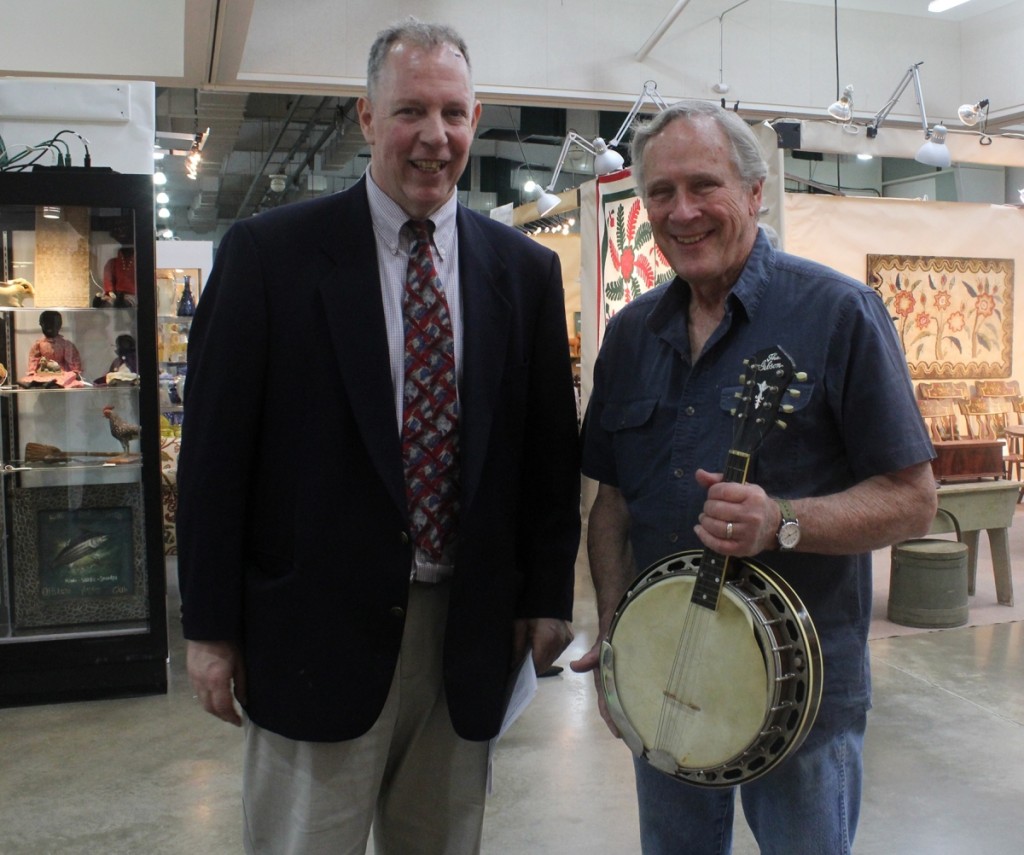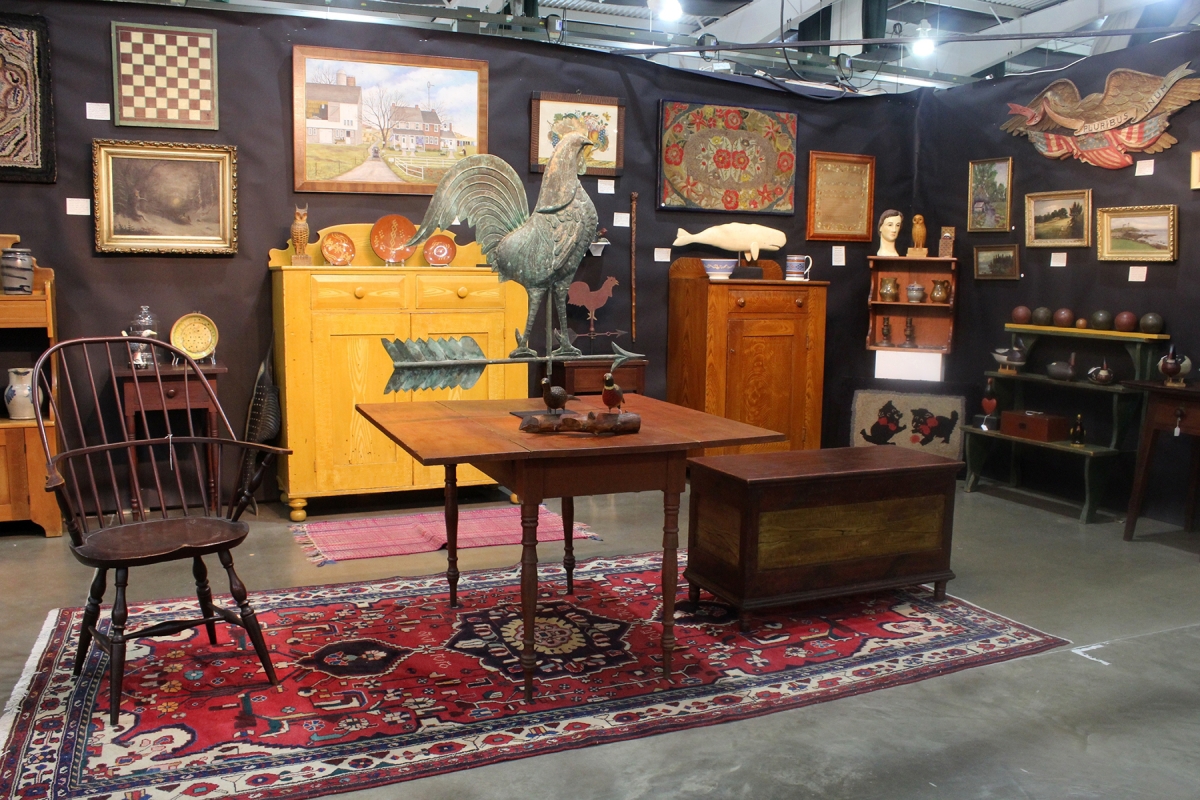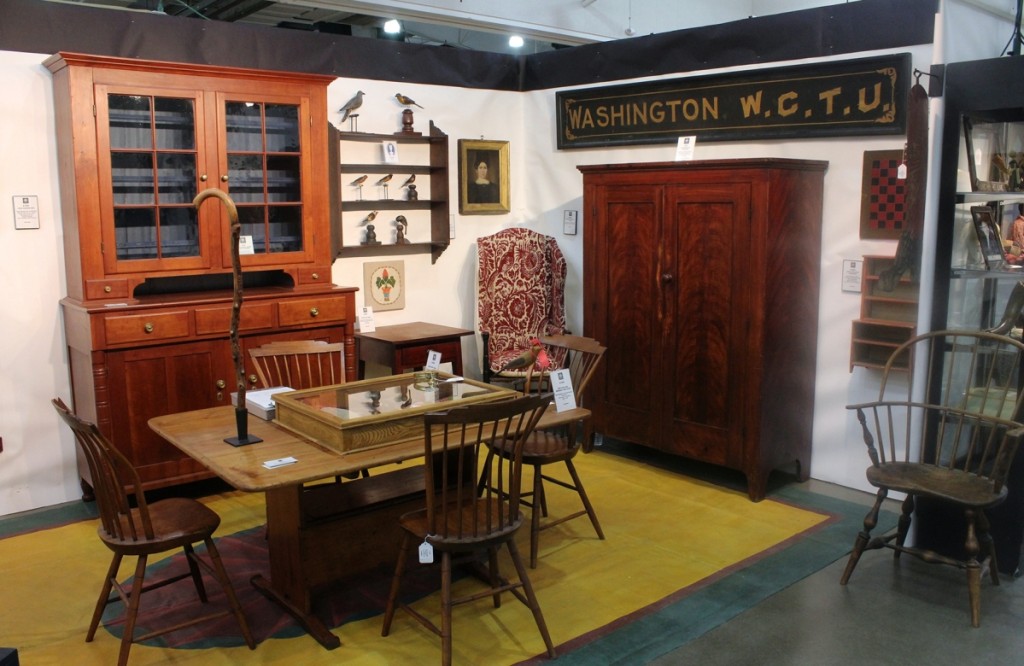Review and Photos by W.A. Demers
YORK, PENN. – In the first spring antiques show since he made the move back to Memorial Hall East from Utz Arena at the York Fairgrounds, Bob Bockius of Mitchell Displays, Inc, assembled 26 dealers on May 4 and 5 for the spring edition of the Greater York Antiques Show.
As was the case last year, the impending start of Brimfield the following week cut into the number of participating exhibitors, but still there was no shortage of Pennsylvania staples, including folk art, ceramics, textiles and country and formal furniture. Indeed, Bockius is so sanguine about Pennsylvania material, he took the opportunity to announce a new show that he will conduct at the Lebanon Valley Fair Grounds on August 31 and September 1 – not surprisingly called the Pennsylvania Antique Marketplace. The 60-dealer show will showcase classic furniture, folk art, lighting, clocks, baskets, jewelry and fine art.
The trademark Kelly green walls in Kelly Kinzle’s booth greeted visitors just to the left beyond the show’s entrance. The New Oxford, Penn., dealer has acknowledged that things stand out well against that color, both furniture and paintings, and such was the case here with a striking Philadelphia lowboy and a pastoral scene of sheep gathered on a hillside.
Richard “Smitty” Axtell is the oldest of three boys in his family. He related vivid memories of childhood involving a Hires Root Beer dispenser on offer in his booth. The 1873 keg with tap would dispense the product of a combination of syrup, sugar and carbonation effected by the addition of marble chips. The dispenser was a feature in the Smiths Drug & Book Store, which itself began business in 1869. Smitty also brought a sign from a covered bridge, dated 1830, and a collection of butter prints and candle molds. A three-board top table from the Eighteenth Century in original red paint, found in Pennsylvania, but believed to be New England was front and center in the Deposit, N.Y., dealer’s booth.
Navajo blankets and other Native American textiles colorfully complement baskets, pottery, signs and architectural elements in the booth of Steve Smoot Antiques & Navajo Textiles, Lancaster, Penn. The booth was highlighted by a one-door Pennsylvania jelly cupboard, circa 1850, all original, and a playful and rare carved tail dappled rocking horse from the 1870s was a centerpiece. A small gem was a rare Navajo miniature rug, circa 1900-10, handspun with Native and animal colors. In the corner stood a folk art music stand and on the wall hung a tinsel painting of an urn with flowers, circa 1900.
They were boothmates. Elinor Penna of Old Westbury, N.Y., was sharing space with 30-year veteran Bill Shaeffer from Glendon, Md., and their displays were complementary, both featuring early American ceramics. A standout on Penna’s side of the space was an assembled group of the Four Elements – earth, air, fire and water – by the early Staffordshire artisans, the Wood family, circa 1810-20. Penna said she had initially found a pair, and then teamed them up with two singles to complete the grouping. She also had figures of Faith, Hope and Charity, along with the Four Seasons by mid-Nineteenth Century potter Thomas Parr. “There was so much interest in my Americana figures and the Uncle Tom collection,” said the dealer after the show.
Shaeffer’s case was filled with Wedgwood creamware and delft plates, including a quintile or finger vase, so-called because of its fan-shaped array of five individual stem holders, cuspidors and animal forms, such as a cow creamer.
Exclusively male shoppers were buying Susan Atkinson’s art, not surprising since Mother’s Day loomed and these objects were appropriate gifts. The dealer, co-owner of Beaver Creek Antiques and Arms, Dillsburg, Penn., mounts large and visually striking seashells on metal stands, and for her display had created a phalanx of these that ran along shelves on either side of her booth. She and her husband Steve Clark founded the firm, which she playfully nicknamed “Bling & Bang,” in 1986, first specializing in country antiques and then branching out into antique and estate jewelry. In 1989, they added a firearms license to control a growing inventory of historical firearms and militaria. She credits the interest in firearms to Clark’s father, who was in World War II and kept a locked blanket chest filled with guns, something that fascinated the 9-year-old. Atkinson herself said she can field strip a Luger and reassemble it in minutes. The arms on display at this show were all percussion rifles, dated 1897 and older.
“The venue is superb: easy move in and move out for the dealers, beautiful room settings of exquisite antiques and an opportunity to catch up with present customers and to make new friends,” summed up Atkinson afterwards. “The antique and estate jewelry sales were brisk both days of the show. There was a great deal of interest in the antique long guns on display in our booth, especially the Lancaster County percussion rifle because of the county’s proximity to the show.”
Business seemed brisk, too, for Clear Spring, Md., dealer Lisa S. McAllister, who, just an hour into the show’s opening had written up slips for a Christmas ornament, a dachshund pull-toy, ceramics and a 6-inch-diameter treen bowl. On the wall of her booth she displayed an interesting “poker” work depicting an African American, signed M.E. Boyer,” dated 1904 on the back and accompanied by a short poem titled “Injured Innocence.”
The work was based on a sketch that appeared in the February 9, 1878, edition of Harper’s Weekly, whose caption at the bottom read: “I hain’t seen nuffin of yer Chickens! Do you took me for a Thief? Do you see any Chickens ’bout me? Go ‘way dar, white man! Treat a boy ‘spectable, if he am black!” At the top of the young man’s hat, three chickens can be seen peering out. McAllister believed the portrait was from the mid-Atlantic region. Also on offer here was a set of French solid wood chairs with original leather seats, circa 1930s, and a great game board featuring the word “HOME” in three-dimensional yellow lettering against a green background. “There was a lot of quality, and people bought,” she said.
“The York Show was good for us,” said Betty Berdan, who with husband Michael Newsom, operates as Newsom & Berdan, Thomasville, Penn. “We sold furniture, folk art and hooked rugs along with some smalls. We had out-of-state customers from Virginia, West Virginia, North Carolina and Washington DC.” Berdan added that although the show was smaller this time, “it was pretty and people seemed to enjoy being there.”
Bill Kurau of William R. and Teresa F. Kurau, Lampeter, Penn., reported interest in a group of Currier & Ives lithographs that they brought, and they sold a nice large folio Currier. “Also sold was a patriotic Liverpool pitcher, circa 1804, with a Jeffersonian quote and examples of historical Staffordshire.”

Carroll Swamm, South York, Penn., right, and Bob Backius of Mitchell Displays, Inc, discuss the features of a circa 1928 Gibson banjo mandolin that Swamm had just acquired from Carol and Gene Rappaport.
A pair of early painted family portraits of a boy and girl, circa 1830s-40s, that had been found in Massachusetts caught the eye in the booth of J.K. Nevin Antiques, Pottstown, Penn. “Why do you believe the sitters are siblings?” dealer Liz McElroy was asked. “Well, you can see that the brother is pointing toward his more studious sister,” she replied. “We always enjoy doing the Greater York show,” added the dealer. “It is very well run by Bob Bockius, and it’s a great, friendly group of dealers. Friday morning saw the busiest sales for us, the dedicated collectors coming when the show opens on day one. Saturday was a bit slower.”
Besides the charming pair of early Nineteenth Century children’s portraits, which she sold, McElroy’s favorite items in the booth were an Eighteenth Century spoon rack from New England, which also sold, and an Eighteenth Century Pennsylvania William and Mary tavern table in original salmon paint. “One of my most spectacular items destined for the show sold before it opened – an exquisite 1840s papier mache doll,” said McElroy.
A walnut and figured maple work table, a great folk art piece, according to its owner, Larry Thompson, was a centerpiece in the Atlanta, Ga., dealer’s display. The rare piece with a pinwheel inlay in the center and hearts in the corners had originated in Catawba County, N.C. Also notable was a Pennsylvania chest and a Hudson River School painting of two young men fishing. The chest was yellow pine, dating to 1760, with lively sponge decoration and a pair of drawers at the bottom.
There were plenty of good things to see from the collection of Camden, Ohio, dealer David L. Good, including a Delaware Valley armchair with rush seat, circa 1785, a small Eighteenth Century Native American wooden bowl from the Eastern Great Lakes and a figural piece of a “one-eyed jack” from Middle, Tenn,, circa 1880, which featured the phrase “Try Me” incised under the nose and eye. Displayed by itself like the jewel that it is was the Johan Weber box from the Ruth Bryson collection that sold for $48,800 at Pook & Pook’s April 14 auction. On a yellow ground, the box is dated 1850 and measures 4-7/8 by 7-3/8 inches.
As per usual, a large Pennsylvania quilt took up most of the back wall at Tex Johnson & Son Antiques, Adamstown, Penn. This time around the dealer was showing a Lancaster County Princess Feather example with a bright chrome yellow background, an excellent piece of quilting. Complementing the quilt’s primary color, a yellow firkin with original mince meat labels out of Philadelphia was on offer.
Robert Conrad Antiques of Yeagertown, Penn., centered an 8-by-3-foot work table in his booth featuring a scrubbed top, original casters and a single drawer at one end. The table’s bona fides were confirmed by Wayne Shultz, a Williamsburg, Penn., American antiques collector and sometimes-auctioneer, who happened to be shopping the show. A rare sideboard cupboard, circa 1800, on offer featured dovetailed case and gallery and glowed with a undisturbed red painted surface, and a miniature blanket chest in original chrome yellow had stippled decoration.
Bluegrasser Carroll Swamm from nearby South York, Penn., was seen walking toward the exit with a small instrument case, so naturally we had to ask him to show us what was inside – a Gibson late 1920s-era banjo mandolin that he was adding to his collection of acoustic stringed instruments. He acquired it from Carol and Gene Rappaport, Strasburg, Penn., dealers set up at the show. The instrument unsheathed, musician “radar” ensued and soon Bob Bockius, himself a sometimes musician, came walking over to swap information on favorite online sites to learn technique. Swamm, incidentally, is not just a bluegrass music fan; he and his wife Linda run the Gatchellville Store in New Park, Penn., filled with antiques, vintage musical instruments and tools.
Oscar P. Fitzgerald, adjunct professorial lecturer at the Corcoran School of the Arts and Design, was on hand opening day to sign copies of his book on antique furniture, American Furniture: 1650 to the Present, and the refreshments were an added bonus. Bob Bockius and his team worked hard to accommodate both dealer and visitor requests, and donated a portion of the proceeds from the gate to charities in the greater York area.
The next Greater York Antiques Show, under the management of Bockius, will mark a milestone on November 16 and 17 at the York Fairgrounds when it celebrates its 50th anniversary. For information, www.greateryorkantiqueshows.com or 856-686-9000.



































